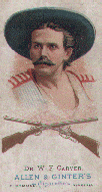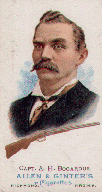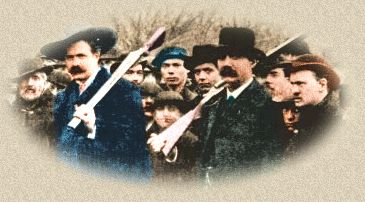

The Sporting Event That
Captivated
America in the Spring of 1883.
Doc Carver vs Captain A. H.
Bogardus
March and April, 1883.
by
Richard Hamilton



Carver (left) and Bogardus (right) in Des Moines,
Iowa after
Carver beat Bogardus 100-97 in their 9th match.
|
|
|
This is the Ligowsky target |
|
The date was February 21, 1883. Finally, the two greatest shots in the world were going to meet head to head in the "Shooting Championship." of the world. They both arrived in Louisville, Kentucky to settle this long standing feud.
He was 6' 4" and weighed 265 pounds. A huge man by the standards of
the day. This was Doc Carver, the "Spirit Gun of the
West." He was born in the little town of Winslow, Illinois in 1840.
He was neither a doctor nor a dentist. As he had always maintained that Carver was a modest man. He never boasted and was a real sportsman. He was thoroughly honest and could not understand how people could be dishonest. Many times early in his shooting career matches were rigged against him with little chance of winning. He always won anyway. He began to read about the great shooters of the day, like Captain Bogardus and Ira Paine. In 1877 he published a challenge to "any man in the world" at 500 glass balls from 25 yards for $500.00. He was hoping to attract a match with Bogardus. It would not come for 6 years. For the next several years he went around the country giving shooting exhibitions and participating in matches. He made trips to Europe and became a world renown shooter. Perhaps more famous than Bogardus. However, no match with Bogardus was forthcoming. Doc said the Captain was an "artful dodger."1 Finally on February 21, 1883, 6 years after his challenge to Bogardus, the two would finally meet. History was in the air. He took up pigeon shooting in 1868 and became the greatest pigeon shooter in the world. He was a man of many talents. He developed a glass target ball and a glass ball trap. He also wrote several books, one on his shooting accomplishments titled Field Cover and Trap Shooting.
Bogardus was a very boastful man, a man with a huge
Now the two titans converged on Louisville for their shoot-out. This was really the coming out party for Doc Carver in shotgun competition. Everyone knew he was a great rifle shooter. The two greatest shooters of all time were finally going to meet, head to head. Bogardus had ducked Carver for 6 years but now it was time. On February 21, 1883 the Louisville Commercial stated:
The next day, February 22, 1883, the match was held at the Jockey Club with the stakes at $500.00 each plus the gate money. One hundred live pigeons each, five ground traps and a 30 yard rise. Doc won the shoot 83-82, thus allowing Bogardus a chance to challenge for further matches, which he did. Doc accepted everything he proposed.
Back in Cincinnati, news of the results of the clay target shoot in Chicago placed a seed in George Ligowsky's2 fertile brain. Perhaps he could get these two great shooters to tour the country shooting his new clay targets as they did in Chicago. What better way to introduce his new invention to America and the world. He had better hurry because unknown to him over in Peoria, Fred Kimble and Charlie Stock were very busy developing a better target. This one was going to be called the Peoria Black Bird, the first composition target, much like the composition targets used today. This target and the others that followed shortly were to render his 100% clay target obsolete. So now the two famous shooting pugilists moved on to St. Louis on the same train to meet once again. Bogardus, still without victory needed a win in the worst way. He was being beaten by a younger and less experienced man twice at pigeon and once at clay targets. In his mind, a shooter inferior to his great talents. He was beaten by Carver in Louisville at live pigeons and in Chicago at pigeons AND Ligowsky clay targets. Bogardus continued to challenge, this time in St. Louis. These matches were major sporting events and attended by thousands. However, when they arrived in St. Louis each gunner received identical telegrams from the George Ligowsky Clay Target Company of Cincinnati, Ohio. This telegram would change trapshooting forever.
Carver and Bogardus were quick to accept this proposition. They also agreed between themselves that the one winning the most matches would take the entire $7,500. The match they had in Chicago with Ligowsky targets was allowed to stand as one of the twenty five matches. Two matches were shot in St. Louis: the official match at Ligowsky clay targets, won by Carver 85-69 (he now led Bogardus 2-0) and the live bird match, this one won by Bogardus 81-79.3 They moved to Cincinnati, home of the Ligowsky Clay Target Company, by train for the next match, in a heavy snow storm. Carver took a 3-0 lead in the series with an 89-74 win. Next, by train to Kansas City where Doc again beat the Captain for the fourth straight time. This one was 91-69. "He has beat me," admitted Bogardus to reporters "but I attribute my bad shooting (and it has been bad to date) to a sore face and a light gun (7 pounds, 6 ounces)....I am accustomed to using a gun weighing ten pounds." The great Bogardus was a one eyed shooter. Doc told the Captain that he should stop closing one eye and there would be no more soreness of the cheek. "Than you shoot with two eyes open, Doctor?" said the old fox, who knew very well that Carver was a two eyed gunner. The big show next moved to St. Joseph, Missouri. Carver won his 5th straight match, this one by 92-63. Bogardus was proving to be no competition for Doc Carver. On March 17th they arrived in Omaha to find the city beside itself. Bogardus finally got his act together by breaking 90 targets but Doc smoked 94 to win his 6th straight match. It was also announced on that date the newly formed "Wild West Show" featuring Buffalo Bill and Doc Carver would be coming to Omaha. In the first 6 matches, Doc won them all, outscoring Bogardus by over 100 targets, 525 to 423. Captain Bogardus was humiliated. He could not seem to come up to his well established high standards of marksmanship. He was awful. He would win only three times, in Columbus, OH, Pittsburgh, PA and Providence, RI. There were three ties along the way. The matches were completed by the middle of April with Doc winning 19 times, losing three times and there were three ties. Doc averaged a .9308 average on the 2500 targets while Bogardus had an .8692 average. Complete list of all matches Finances of the tournament. |
|
|
||
| 1
Spirit Gun of the West by
Raymond Thorp. Arthur Clark Co., 1957
2 George Ligowsky invented the first clay target in 1882 in Cincinnati, Ohio. Popular at first, they were very hard to break and "rung like a bell" when hit. 3 Shooters of today might be interested in knowing what guns were used in this famous touring contest; it was the most famous in the history of shooting in America. Both were English shotguns and certainly were the state of the art guns during the period. There were non better in the world. Compare to today's Perazzi, Seitz or Kolar.
|